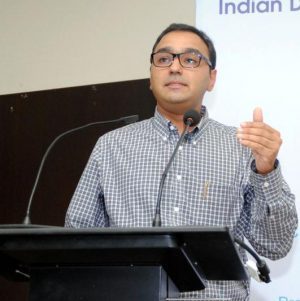- Home
- Editorial
- News
- Practice Guidelines
- Anesthesiology Guidelines
- Cancer Guidelines
- Cardiac Sciences Guidelines
- Critical Care Guidelines
- Dentistry Guidelines
- Dermatology Guidelines
- Diabetes and Endo Guidelines
- Diagnostics Guidelines
- ENT Guidelines
- Featured Practice Guidelines
- Gastroenterology Guidelines
- Geriatrics Guidelines
- Medicine Guidelines
- Nephrology Guidelines
- Neurosciences Guidelines
- Obs and Gynae Guidelines
- Ophthalmology Guidelines
- Orthopaedics Guidelines
- Paediatrics Guidelines
- Psychiatry Guidelines
- Pulmonology Guidelines
- Radiology Guidelines
- Surgery Guidelines
- Urology Guidelines
Bengaluru surgeon removes largest rare Carotid body tumor

Dr U.S. Vishal Rao, a head and neck surgeon from Bengaluru, has recently operated a 38-year-old patient and removed largest ever carotid body tumour at HCG Hospital. The case of the same has been submitted for publication in the Indian Journal of Surgical Oncology
Carotid body tumors (CBTs) are rare neoplasms, although they represent about 65% of head and neck paragangliomas. They are considered to be a disease of middle age and the mean age of onset is reported to be 45 years
The resection of these tumors has remained a problem because of the complications, but modern imaging and current surgical and vascular techniques have significantly improved the safety and success of this operation.
In the present case, the patient, 38 years was carrying this rare tumour. Apart from its peculiarity, the tumour was also the largest size ever presented, states the oncologist.
“It was by far the largest size presented to us or reported literature. It was 10 cm, extending from neck to base of skull completely encircling the blood vessels that supply blood to neck and brain. Its positioning was such that a wrong surgery could lead to a permanent damage or stroke,” explained Dr Vishal, while speaking to Deccan Herald. A case which is more commonly seen among mountaineers for lack of oxygen, however, affected the patient for unknown reasons. The patient had, however, walked in for surgery, not at the onset but had waited for some 2-3 years assuming it to settle down.
“In his case though the tumour had rapidly increased in size and touched the base of the skull. That's when he got alarmed," the doctor added. Since the patient was covered under the ESI scheme, the doctors from ESI hospital had also come to observe the surgery. The doctors had various techniques to perform the surgery and, among them, the common technique is to dissect the carotid body tumour to address the external carotid artery at the initial steps of the surgery.
The dissection is usually initiated from the common carotid artery, and then, the tumour is dissected off the external carotid artery. The internal carotid artery is dissected towards the final step after the external carotid artery is freed of a tumour.
“However, we went ahead with the technique which is considered difficult but is more fruitful. We started with internal carotid artery (ICA) dissection. It saves time and the surgery gets faster,” Dr Vishal told Deccan Chronical.
Carotid body tumors (CBTs) are slow-growing mostly asymptomatic tumor with unknown cause with only known risk factors of presence of chronic hypoxic stimulation and the genetic predisposition.
Dr. Vishal Rao has vast experience in the field of Oncology and Head & Neck Surgery and has been trained in Oncology at one of the most prestigious cancer institutes of India, Tata Memorial Hospital at Mumbai.

Disclaimer: This site is primarily intended for healthcare professionals. Any content/information on this website does not replace the advice of medical and/or health professionals and should not be construed as medical/diagnostic advice/endorsement or prescription. Use of this site is subject to our terms of use, privacy policy, advertisement policy. © 2020 Minerva Medical Treatment Pvt Ltd